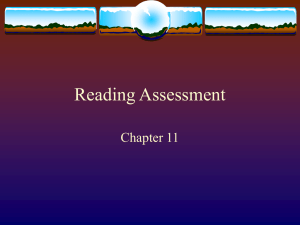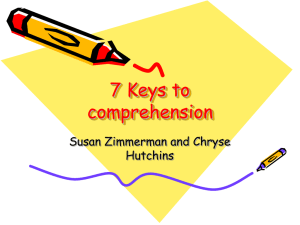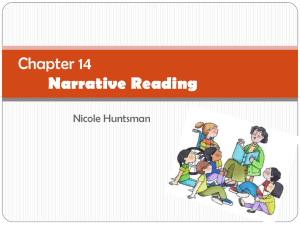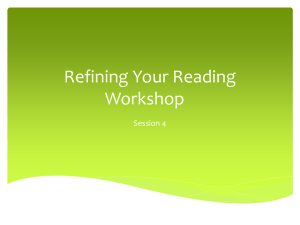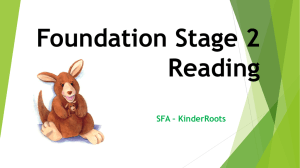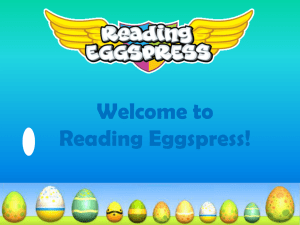MABEY---CH 14 Narrative Comprehension
advertisement
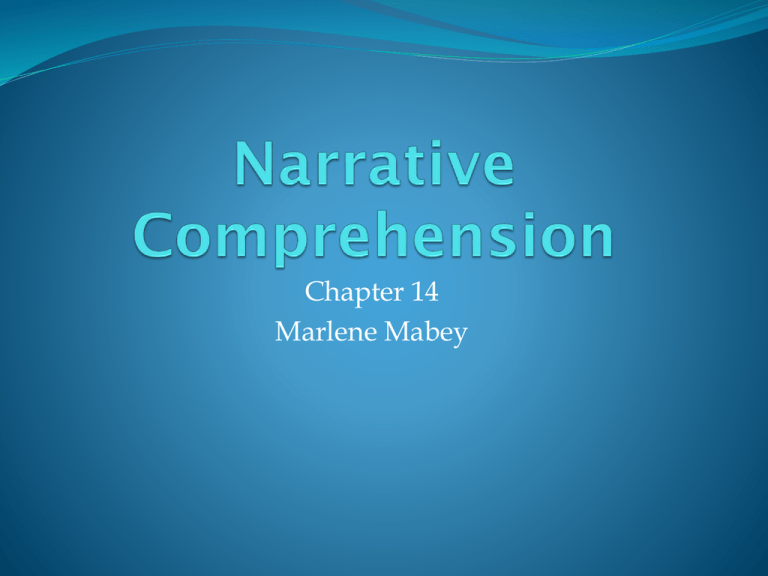
Chapter 14 Marlene Mabey WHAT? Story structure How stories are systematically organized Story structure gives predictable meaning to stories How stories are structured Setting Characters Plot Theme WHAT? Story structure knowledge drives the application of comprehension strategies to narrative text Strategy Application Recognizing story structure enhances memory Asking questions helps promote active reading Answering questions directed by the teacher promote deeper level of comprehension Monitoring comprehension involves noting progression Connecting to world knowledge enables students to understand Predictable phrases are excellent for developing skills of prediction Constructing mental images Summarizing or retelling WHAT? Multiple-Strategy Instruction Program: TSI Emphasizes collaborative discussion among learners Focuses on Metacognition Motivation Reader response Understanding text equally important to learning use of comprehension strategies “Transactions” between text, readers, peers and teachers WHAT? Reader Response The interaction with stories and form personal responses that influence their interpretations Discussion-oriented instruction Discussions supports students as they develop understanding Writing in Response to literature Use before, during and after reading WHY? “Strong evidence links readers’ awareness of text structure to successful reading comprehension.” Coyne et al., 2007 Story elements provide the framework for applying comprehension strategies to narrative text. Dickson et al., 1998 Helping students to recognize the structure inherent in text—and match it to their own cognitive structures--will help them understand and produce not only text but also spoken discourse. Williams, 2005 WHEN? Comprehension instruction should begin as soon as students start to interact with text and should continue through high school. Duke et al, 2002 Effective teaching balances explicit comprehension strategies instruction with the literary experience of a story. WHEN? Comprehension instruction should be accompanied by reliable assessment aligned with instruction. Informal and traditional assessments should be combined Most traditional assessments are inadequate 1. They often confuse comprehension with vocabulary, background knowledge, word reading ability, and other reading skills 2. They fail to represent the complexity of comprehension 3. They do not distinguish specific processes that underlie comprehension problems WHEN? Comprehension assessment tools Think-aloud protocols make comprehension processes more visible Process-focused measure may serve as useful tools for diagnosing and remediating comprehension problems. HOW? Dialogic Reading: Picture Book Read-Aloud Method Teacher become the listener and questioner Student is the teller Commonly used with picture books Fosters engagement Give access to books before they can read them independently Uses CROWD and PEER HOW? Dialogic Reading Prompts (CROWD) Completion Recall Open-minded Who, what, when, where, why questions Distancing –making a bridge between stories and real world HOW? Interactive Instrumental Sequence (PEER) Helps students become the teller of the story PEER Prompt –use CROWD prompts, student responds to a story Evaluate—evaluate student response Expand—expand by adding info to student response Repeat—repeat expanded response HOW? Story Structure Students ask and answer questions about story structure Students use story maps after Direct instruction Teacher modeling HOW? • Transactional Strategies Instruction (TSI) • • • • Emphasizes coordinated use of strategies to help students to build and monitor comprehension First introduce individually Explicit instruction needed Strategy choices shifts from teacher to student over time HOW? • Book Club • • Writing in response to literature Provides instruction in three categories • Personal responses---relating to story personally • Creative responses---new ideas • Critical—analyzing aspects of literary works

